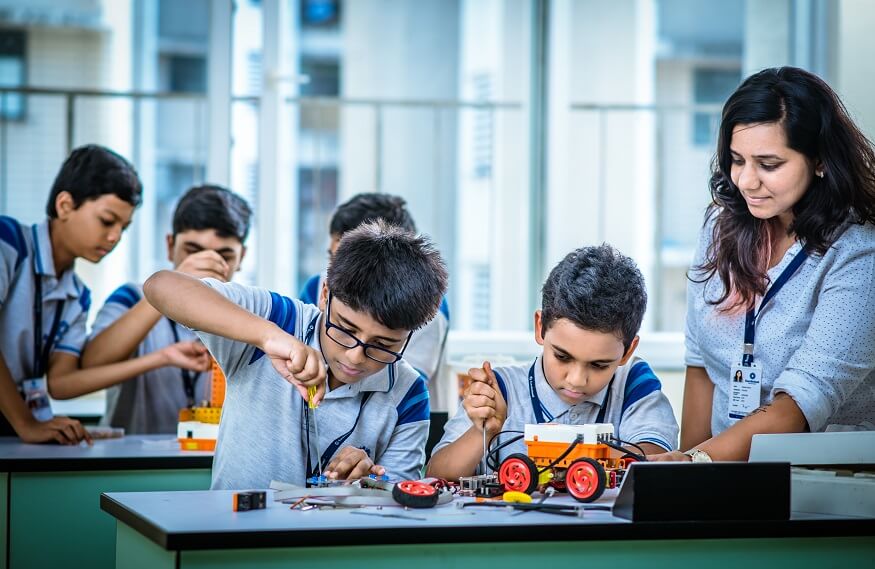Physics facts are present in all aspects of our lives. From the pre-scientific past to our modern era, physics is everywhere, whether you are walking, running, jumping, tossing, dancing, or simply doing nothing.
Physics is the superhero of science, as it is the basis of all other experimental sciences for students. It helps us to understand why things fall, why the Earth spins, and why humans don’t float away into space. Physics in everyday life helps improve our understanding of the natural world while also laying the foundations for many technological developments.
Whether you are looking for ICSE or CBSE schools in Mumbai, our expert faculties ensure to offer the best visual and practical learning experience to all aspiring and brilliant minds learning at EuroSchool.
By observation, experimentation, and the development of mathematical models that describe the fundamental laws of the world, physics in daily life aims to solve the mysteries of the universe. It examines the complicated interactions of particles, forces, and fields. But Physics is not about those complex mathematical glory, because most people after school or college would forget these equations and theories unless they get into a technical field. Through simple physics facts in everyday life, we can understand its importance. Let us look at the 10 examples of application of physics in daily life.
Application of physics in daily life:
Walking and Running:
One of the simple examples of physics in everyday life is the frictional force which helps us to walk or run easily. It acts like a “grip” between your shoes and the ground, which helps you to walk or run without slipping. It depends on two factors; one is the surface you are walking on and the other one is the weight that is pushed down on the surface. Friction allows us to have control and stability while moving.
Walking on a carpeted floor is easier because the rough texture of the carpet creates greater friction, which helps the shoes to grip the fibres and prevent slipping. But if you are walking on an icy surface, the smoothness of the ice reduces the traction between the shoes and the ground. This results in less friction and it’s difficult to walk or run on ice without slipping.
Alarm clock:
Most of us hate the sound of the alarm clock and love to press the snooze button. The annoying sound that wakes you up is a classic example of physics in daily life. The sound which you can’t see but only hear travels in the waveform.
Mechanical energy conversion concepts are used in alarm clocks. Potential energy is stored in a coiled spring when the clock has been wound up. The potential energy in the spring is turned into kinetic energy when it unwinds, which drives the clock mechanism. As a result, sound waves of high frequency are produced which wakes you up. Amazing, isn’t it?
Well, there is no fun in learning if a bit of practical examples aren’t involved. At EuroSchool, we strive to make learning fun and easy to remember for our students learning in ICSE or CBSE schools in Pune.
Ballpoint pen:
People say the pen is mightier than the sword. Physics plays a major role in using a pen as a tool for writing. The design of the ball pen explains the physics facts in everyday life. When you use a ballpoint pen, it involves principles of fluid dynamics and friction. There is a small spherical point object at the tip of the ball pen. When you apply pressure to the pen and move it across the paper, the ball rotates and rolls.
As it rolls, it picks up ink from the refill, which is a small tube filled with ink inside the pen. Because of the gravitational effect, the ink flows through the ball and then onto the paper. This mechanism ensures a smooth flow of ink and allows you to write or draw with precision.
Roller coasters:
Concepts such as gravity, acceleration, and inertia are used here. The roller coaster is initially dragged up a steep hill, storing potential energy. The potential energy is turned into kinetic energy when it rises the slope, ending in an exciting drop.
The track’s twists, bends, and loops influence forces like gravity and centripetal force, resulting in amazing moments of feeling weightless and tremendous g-forces. These aspects work together to provide an adrenaline-pumping experience while sticking to laws of physics that keep riders safe and engaged.
If your child loves going on adventures, our expert teaching faculties in ICSE and CBSE schools in Hyderabad will ensure to keep them intrigued with fascinating physics concepts adjoining with real-life theories.
Fans:
Fans, the most needed thing in summer, depend on fluid dynamics and electromagnetic concepts. When a fan is turned on, the blades inside it revolve. As the blades rotate, they produce a low-pressure zone behind them. This low-pressure zone encourages air to flow from higher-pressure places, such as the surrounding room, to the fan.
The rotation of the fan’s blades and the design of the fan’s housing drive the flow of air in a specified direction. Fans use these physics principles to circulate air, which provides cooling and ventilation in houses and buildings.
Refrigerators:
Refrigerators work on thermodynamic and heat transfer principles. Refrigerators use the process of heat transfer to remove the heat from inside and release it outside. The refrigerator’s continual sequence of compression, condensation, expansion, and evaporation allows it to keep a low temperature and preserve our food and beverages.
Cell phones:
If you say you don’t have a cell phone, people will think you are an alien. For user interaction, the touchscreen makes use of changes in electrical charge. Wireless communication involves the transmission of electromagnetic waves.
The device’s components, such as the batteries and microchips, operate on electromagnetism and electrical circuit principles. This clearly explains the role of physics facts in everyday life. Cell phones have become vital instruments for communication and connection in our daily lives as a result of these physics concepts.
However, our interesting teaching practices used at our ICSE and CBSE schools in Bangalore will ensure your child is never bored and always gets excited to learn new concepts or physics.
Aeroplanes:
Flight physics is critical in aviation. Aerodynamics manages the forces that act on an aeroplane’s wings to allow it to fly. Bernoulli’s principle and Newton’s laws of motion are essential concepts for designing and operating aircraft.
Batteries:
Batteries are an essential part of physics in daily life. A chemical reaction happens inside a battery, resulting in an electron flow. This flow generates electric current by creating an electrical potential difference between the battery’s terminals. Our devices are powered by the flow of electrons through the circuit.
Electron behaviour is governed by physics principles such as electromagnetism and electrical circuits, allowing batteries to provide portable and reliable sources of energy for a variety of applications.
Automobile:
Several physics ideas are incorporated into automobiles. The engine uses combustion and thermodynamic principles to transform fuel into mechanical energy. The interaction of forces such as friction, inertia, and aerodynamics is involved in vehicle dynamics.
Conclusion:
In one way or another, physics governs the whole universe. At EuroSchool, we understand that by being aware of the physics facts in everyday life we can understand the natural world, and improve our daily lives. It gives us the ability to develop original ideas, enhance current procedures, and make wise decisions in our personal and professional lives.










